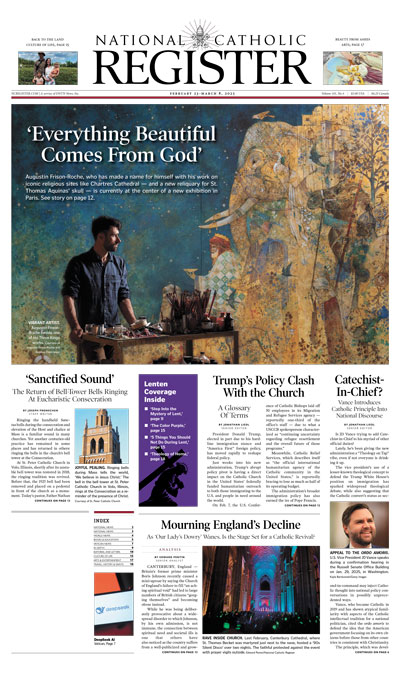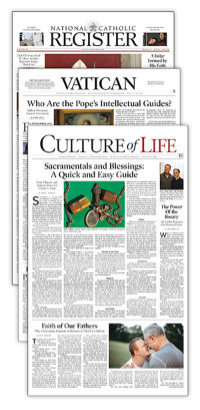‘A Truly Universal Church’: Americans Share Unexpected Moments From Pope Francis’ Funeral
Families, seminarians and state Catholic conference executive joined the crowds converging on St. Peter’s Square to honor the Pope.

For many American Catholics in Rome last week, what began as a vacation or pilgrimage became a trip of a lifetime as they found themselves among the 250,000 mourners bidding farewell to Pope Francis.
The Register spoke with several who traveled from the U.S. to the Eternal City for Easter, the Jubilee of Teenagers, and the canonization of Carlo Acutis. For these travelers, itineraries developed over months of careful planning and eager expectation were scrapped with the news that the Pope had died.
So, what was it like to be — maybe even by accident — at the funeral of the leader of the Catholic Church and successor to St. Peter?
Without VIP passes or tickets, they joined the crowds converging on St. Peter’s Square to honor the Pope. Several told the Register that they left with something they might not necessarily have discovered from an assigned seat with a great view of the proceedings: a tangible sense of being members of a truly universal Church.
Colin and Aimee MacIver of Covington, Louisiana, had been on a family pilgrimage in Rome, with their two children, when they learned that the Pope had died. On Thursday, they lined up outside St. Peter’s Basilica at 6:30 a.m. to see the Pope lying in state.
“It was just striking that there were people from all over. We noticed a lot of priests and religious and laity and people speaking many different languages, all in a growing queue,” Colin said.
“The thing that really stood out to me was just how many people were there, and then of that number, just how diverse the group was,” Aimee told the Register.
“The word ‘universal’ kept coming into my mind and in my heart, just watching that crowd, because it was so representative of what it means to be Catholic, which really is universal,” she said.
Seeing people of all ages, speaking different languages left an impression on her, she said.
“It was a really strong sense of the community of faith. And it’s hard for me to image any other community of faith other than the universal Catholic Church having that kind of experience. It was really compelling how it was all these thousands of people in line when we were there,” Aimee said.

To see the Pope lying in state, a few days after seeing him give a blessing at the reading of his message urbi et orbi on Easter Sunday, and after seeing Blessed Carlo Acutis’ body in Assisi, Italy, Colin said, made a real impression on his family.
It was “a chance to talk about resurrection and really, just the beauty of our faith, being an Easter people. People who are not afraid of the cross and the reality of death, but who look toward eternity,” he said. “And that was a really powerful experience for us.”
Jenny Kraska, executive director of the Maryland Catholic Conference, was in Italy to give a speech at her alma mater, the Angelicum, and to visit Sicily. She had changed her airline tickets for the funeral.
Kraska attended the praying of the Rosary in St. Peter’s Square on Monday evening and the procession of the Pope’s body from Casa Santa Marta to St. Peter’s Basilica. And after standing in line for four hours, she was able to view the Pope’s body lying in state.
On the day of the funeral, she woke up early to stake out a good spot in St. Peter’s Square. While she managed to find “a much better spot than I thought I was going to get,” she felt moved to walk around to get a sense of how many people were there.
As she moved further away from St. Peter’s, she saw thousands of people as far away as Castel Sant’Angelo, which was once used by popes as a fortress and castle, many of them watching the funeral on screens set up in Rome’s public parks.
“For me, it was deeply moving to see people. The overall tenor of the day during the funeral was really peaceful, it was really almost like a reflective sort of spirit,” Kraska said.
“There were people who were definitely sad, but I would say, overall, the general mood of the day was one of celebration for a life that was fully lived in faithful service to the Church,” Kraska said. “And you could really feel that aspect of it, that feeling.”
Alexis Love and her husband John had traveled from Maryland with their eight children ranging in age from 3 to 20, along with friends and family members for the Jubilee of Teenagers and Carlo Acutis’ canonization, which was postponed due to Pope Francis’ death.
On their way to the funeral on Saturday, their group of 28 was “at the back” of the Via della Conciliazione, the road that runs directly into St. Peter’s Square from Castel Sant’Angelo, and could not see any of the proceedings from that distance.
“We were kind of at the back of the crowd, and so we actually did have enough room to kind of sit down on the ground during the readings and the homily,” Love said. They followed what was going on by tuning into a livestream that translated the readings into English.
One of the most memorable moments of the day, Love said, happened after they had received Communion and headed to the embankment by the Tiber River. As the group looked up at the bridge above them, they saw Pope Francis’ funeral procession drive past as crowds gathered to bid him adieu as he made his last trip outside the Vatican.
“It was an interesting view, being below street level, but you could still see him go by and people cheer. And so I think people lining the streets was really a beautiful testament,” she said.
At the funeral, she had seen a lot of people who seemed to be from Rome “vaping and chatting on the phone,” but she was struck, at that moment by the connection the Pope had made with the local people.
“It’s still a testament to the people of Rome’s affection for him, that they would show up, even though they didn’t seem particularly devoted.”
Reed Robinson and Jamie Severson, two seminarians at the Pontifical North American College, were both traveling during their Easter break when they learned that the Pope had died.
Robinson, a 25-year-old native of Nashville, Tennessee, in his third year at the seminary, returned early from a trip to the Balkans to take part in the Pope’s funeral. He assisted in the distribution of Communion for Mass and was seated with a hundred or so seminarians from around the city.
He, too, was struck by the number of people at the funeral as he offered Communion to the public.
“It was kind of hectic. I had people kind of on every side in front of me, and I was shifting left and right to try and find people,” Robinson said.
“It really was just such a gift to be able to not only be a part of the Mass, to aid in seeing Pope Francis off, but also in such a profound way to be able to distribute the Body of Christ, to encounter people,” he said.
“Pope Francis talks so much about encountering others and seeing God in them. And to be able to do that in such a special way, and encountering people in a moment where I can literally hand them Jesus Christ, the Body of Christ, so they can encounter the Lord in such a special way, it was really a grace and one that I will remember hopefully all my days.”
Severson, 27, from Bozeman, Montana, in his first year at the seminary, learned of the Pope’s passing while on a train from Rome to Assisi.
“It was a beautiful experience to be able to pray at the place where St. Francis died for the repose of the soul of Pope Francis,” he told the Register.
Once he got back to Rome, he and his fellow seminarians tried to attend the wake for Pope Francis, but after standing in line “for quite a while,” they were turned away.
On Saturday, however, the group of seminarians walked for three hours, slowed down by crowds of people headed for St. Peter’s, and finally met up with a group that had secured a spot with “a really good view of the altar.”
A moment that he will always remember is when the casket was being carried out.
“That was just a really beautiful scene. It just seemed like the whole world was watching this one event happen, where they were bringing Pope Francis’ body out, and everyone was just pretty silent and still,” he recalled.
“And at the same time, all of the choir music was swelling and just getting louder, and it was a really beautiful moment,” he said.
Having entered the Church in 2017, Severson said, he has been inspired by Pope Francis, the only pope he has known as a Catholic.
“One of the main things that kind of helps me remember Pope Francis is he definitely is a pope of the people. You know, he was always making visits to the poor, going to the prisons, visiting widows. And he always just had such an eye for the poor, even from the start, taking the name from St. Francis, who had a heart for the poor,” he said.
“And so I think he’s just an incredible example to our world and to seminarians and priests to carry out our mission in a way where we never forget the poor and the marginalized as we go on our journey towards Christ.”
- Keywords:
- Pope Francis’ Funeral
- universal church














